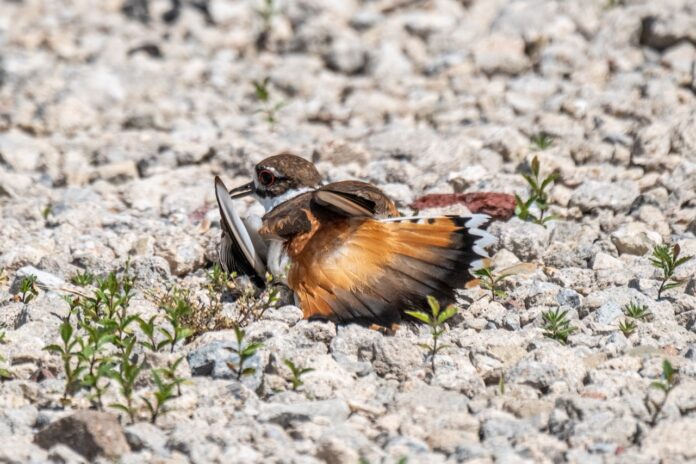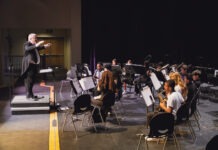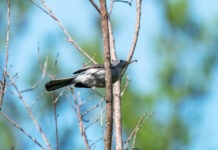
If you drive north into the rest of America, especially if you haven’t been there for a while, it can feel like surfacing in a pool after an overlong submersion. Everything is familiar and strange all at once, but also maybe a little blurred, as if your eyes are fogged by chlorine.
This applies to the human-made landscape – the strip malls and parking lots and fast-food places – but also to birds. Living in the Keys we see a good number of bird species. Mostly we see them as migrants passing through, or as winter birds. We see their vacation selves, when they are almost off duty, when they are not trying to find a mate or stake out territory or raise and protect some chicks. Also, they generally don’t sing here. You hear chips and contact calls, but you don’t really get their full songs or their full selves.
I can’t tell you how (internally) excited I was to drive through Arkansas and see the occasional scissor-tailed flycatcher on a wire. Or to hear a common yellowthroat singing in a bush. Or to see the occasionally lone turkey vulture flying slow loops overhead. It was like getting to see the home lives of beloved celebrities.
Delving deeper into the continent, I found myself taken aback by just how much bird noise there is. There is the dawn chorus, when birds seem compelled by some genetic need to tell the rest of the world that they are awake. (I know a few people like this.) But there is also just a day-long twitter conversation, even when the sun is at its highest point. A singsong talk, talk, talk, all day long.
The most common and commonly heard bird? The killdeer. We see a few of them in the winter here in open fields, in parking lots, at beaches, along the edges of runways. But we have nowhere near the number as on the mainland. I really did not understand how common they are. The route of my road trip was a zigzaggy one, from Key West to Denver. And pretty much any time I got out of the car, I heard a killdeer.
Killdeer are shorebirds whose lives are not shore-dependent. A cornfield is as good as a beach for them. I’m pretty sure every baseball field in America is home to at least two of them. (The northern population migrates. Their southern population doesn’t.)
They are rather easy to recognize — about ankle high on a human, with a tendency to run 10 yards, stop, then run another 10 yards, as if given commands in a game of freeze tag only they can hear. A lot of shore birds will have a black collar around their neck or the upper part of their breast. Killdeer have a double collar.
Killdeer are one of the few birds we have in North America with a monotypic name. No modifiers like common, northern, black-throated, greater, lesser or pileated. They get away with a single word, like Madonna or Columbo. The name does not derive from a murderous attitude toward hoofed ruminant ungulates, but to their flight display call, which, if you’re in the right frame of mine, does sound like their name.
Midway through this trip I found myself in a backlot in an industrial area of Wichita, Kansas. It was a very cool place with about an acre full of vintage cars, most of them in terrible shape, rusting and dented, with smashed windows and the occasional bullet hole. Basically a photographer’s dream. I was busy taking pictures when I heard my 50th or 60th killdeer of the trip.
I ignored it, walking around, gravel crunching under my feet, focused on a cool-looking flat-tired pink 1959 Chevy Bel Air lying belly down on the ground. But the bird kept getting more insistent, coming into my peripheral view, and then running away. Its call went from the clear, strong notes that give them their distinct sound, to a bubbly, staccato series of weaker notes.
Finally, when the killdeer came into my vision again, I looked away from the Bel Air and followed as it walked across the gravel. It was dragging one wing, and lying down every few steps as if it couldn’t go on. When I didn’t move, the killdeer came back and did the same thing again. The message was clear, even if the bird was, in theatrical terms, chewing the scenery, the message being, “Hello Mr. Predator! Look how vulnerable I am. It would be so easy for you to catch me if you just followed me over here. How could I fly away with a broken wing?”
Birds are not known for their subtlety, largely because they don’t need it. And what the bird was doing was called a distraction display – trying to draw me away from a nest that was, no doubt, somewhere near where I stood. Killdeer don’t make much of a nest. It’s usually a scrape surrounded by a couple rocks or some weeds. You may not even notice if you stepped on one.
The first thing I did when I realized what was going on was look at the bottom of my sneakers, which were mercifully clean. Then I started walking away, surveying the ground carefully before each footstep.
I did eventually spot the nest – three speckled green eggs about an inch and a half long each – and managed to avoid it. Then I went to the car and put the long lens on my camera, taking a few pictures of the killdeer, which was still carrying on, despite me moving away.
They’re not the only birds that do distraction displays. In the Keys I’ve seen Antillean nighthawks and black-necked stilts do them, too.
But I’m glad this bird did me the honor of going through such histrionics. I don’t care how many killdeer there are in the world. There’s always room for a few more. And I had enough shots of that pink Bel Air anyhow.

























